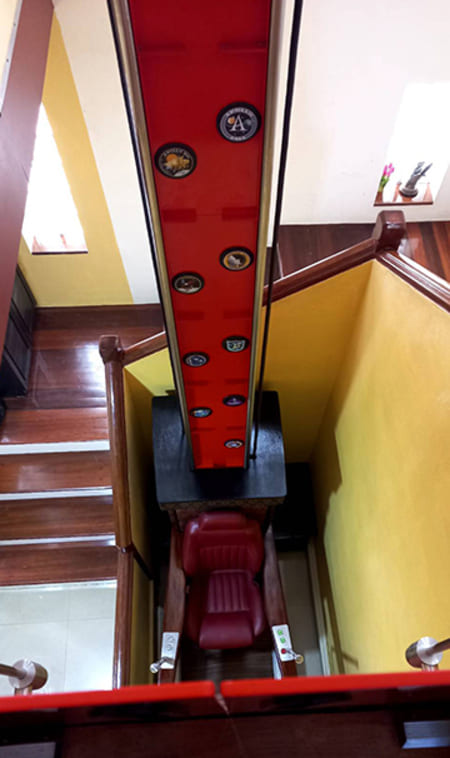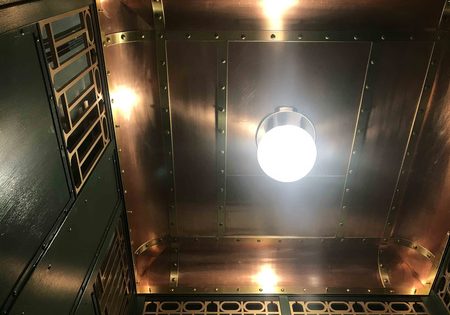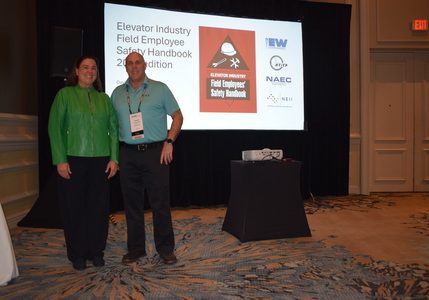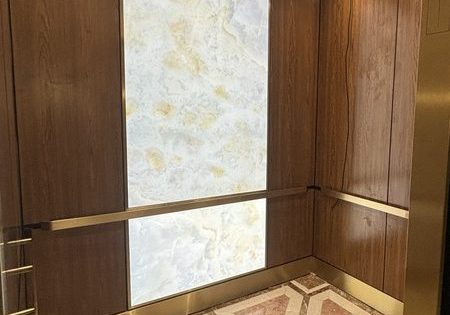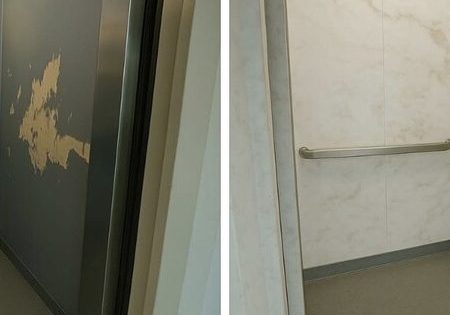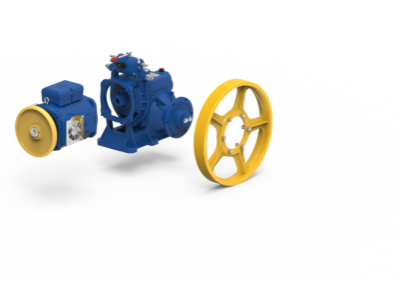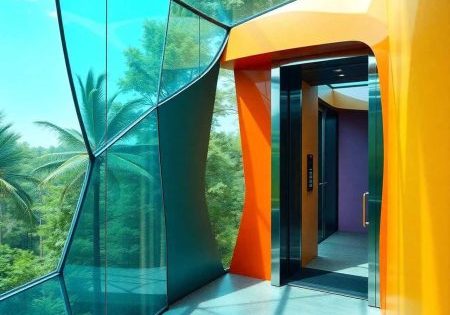One-of-a-kind elevator realized for client in Bangkok, Thailand.
by Richard Draper
With eye-catching crimson interior tower walls, native hardwood flourishes, stainless-steel (SS) corner guides and door panels hidden within decorative panels on either side of the entrance, the custom residential elevator system serving the two-story home of an elderly couple on the outskirts of Bangkok, Thailand, would look right at home on Season 3 of The White Lotus. Its design is unquestionably unique, fulfilling the client’s request that it be a standout feature of the home. An elevator with a fixed seat — upholstered in dark red leather — with all the features of a conventional passenger elevator — was proposed and accepted, with the project completed in October 2024.
The elevator is installed within the confines of the existing stairwell of a wide staircase rising 3.2 m. A solid banister, 0.9-m high, separates the staircase from the stairwell. Available dimensions within which to work were a floor area of 2 m2, width of 1.20 m and depth of 1.70 m plumb to the ceiling at +6.20 m travel height of 3 m allowed for a .20-m pit.
The client had specific ideas for the look of the elevator, located within a staircase unbound by any hoistway structure or enclosure. No changes, additions or attachments were allowed to the existing concrete staircase. The staircase is finished with hardwood treads and a solid banister topped with a profiled timber rail. An open-air arrangement with no cabin enclosure was a requirement of the elevator design.
Concept
To meet the client’s requirements and taking into account hoistway dimensions, it was decided the safest option for a lift without a cabin enclosure was to have the passenger sit to ride.
To meet the requirement that no alterations or additions be made to the existing masonry, a freestanding central structure along which the elevator would travel was conceived. This structure, consisting of a tower formed from interlocking modular pieces of metal secured to a supporting baseplate, forms the core of the installation. The baseplate was engineered to transfer and distribute elevator loads evenly to the floor structure and foundations. Adjustable footing pads installed on the underside of the baseplate provided a means to set the tower so it stood plumb, level and stable. At each of the four corners of the tower, round guides provide runners on which the car travels. The red powder-coat paint finish with SS guides helps the tower assembly fulfill its role as a decorative, standout feature.
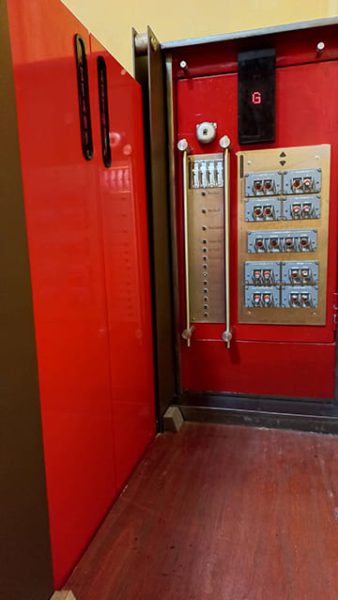
The car platform and seat, engineered to lift 150 kg, attaches to the front of the elevator’s carriage frame. To balance the loads imposed by the platform, a counterweight was mounted to the rear of the carriage frame. Roller shoe guides support the carriage and allow it to run smoothly and effortlessly on the SS guides.
Manufacture and Installation
The modular blocks for the tower were formed from laser-cut steel sheet, creating plates that interlock with one another to form individual rigid blocks. After assembly, a powder-coat paint finish was applied. Locking pins in the base of the block with slits in the top enabled ease of assembly during the stacking procedure. The pin-and-slot system employed simplifies assembly and ensures correct alignment with the adjacent block. With all the blocks stacked, the SS guides were installed and the capping plate was placed. Tensioning the tower and guide assembly completed the tower installation process.
The drive system is bottom drive-side mounted. The motor bed plate slots into the baseplate and is bolted to the side of the tower assembly. The FAXI hoist motor is comprised of a mini gearless permanent magnet synchronous motor (PMSM) with an end-mounted disc brake. The 3-phase PMSM motor is rated at 0.9 kW.
A pulley block unit within the base of the tower and a corresponding pulley block assembly at the top of the tower completes the structure’s suspension means. The suspension system consists of two 300-mm wide flat belts rated at 32kN each.

The elevator serves two stops and is fitted at the first and second levels with individually power-operated half-height center-opening landing doors. Landing doors are manufactured from single-sheet, 6-mm steel with a power-coat finish. Tracking and a motor drive installed below the floor sill provide the means to open and close the doors smoothly. Landing entrances are designed as standalone units, allowing for factory assembly, parameterization and testing. At the jobsite, positioning and alignment with the datum lines and setting in place was all that was required to install the units. The BST door control, speed and open-end/close-end profiles are adjustable through the door controller’s onboard service tool. Light ray sensors provide passenger protection against door closing, and built-in pressure sensors (adjustable sensing) through the door controller reverse the doors, as required by code. When open, door panels are hidden within the decorative panels of the jambs on either side of the entrance.
The client had specific ideas for the look of the elevator, located within a staircase unbound by any hoistway structure or enclosure.
The STEP® AS380 elevator control system provides a fully automatic service with all functions and safety features expected of a conventional passenger elevator. An integrated 32-bit main board coupled with a variable-frequency drive is at the heart of the control system that connects, via CAN bus, to auxiliary input/output signals from equipment on the car and the two landings. A domestic single phase 220-V AC power supply allows the elevator to operate from a standard 13-A outlet at full-load up travel, drawing 5.2 A.
A carriage follower traveling below the car carriage ensures the two traveling cables run in a controlled manner.
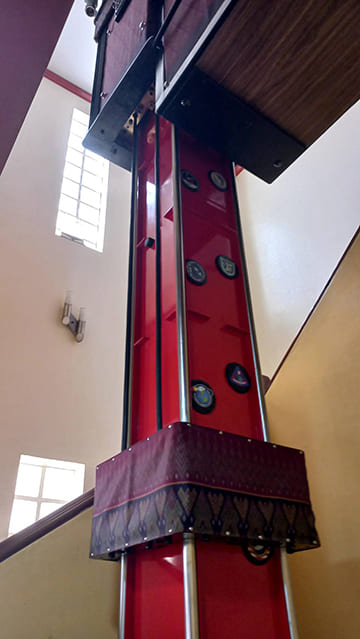
The integrity of the inner steel cores of the two suspension belts are monitored and, through the controller’s safety interface, the elevator is removed from operation if an issue is detected. A slack or broken belt will cause the mechanical safety jibs to instantaneously lock the car to the four guides.
Should a main power failure occur during elevator travel, the controller will switch automatically to rescue mode and, as long as the system’s safety-monitoring devices are intact, allow the elevator to find the floor level and open the doors.
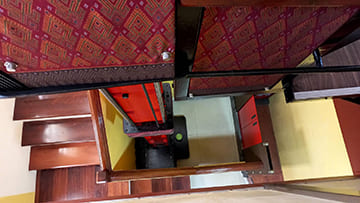
In the event of a hoist motor brake failure, the elevator carriage moves with gravity, and eddy currents generated by the uncontrolled PM motor limit the speed to a safe crawl. If uncontrolled movement with an open door is detected, the controller shuts down and remains out of service until a qualified elevator technician manually checks and resets the system.
A Statement Feature
In keeping with the client’s request that the elevator stand out, custom-manufactured lighting and indicator housings were provided. Decorative finishes to the carriage follower and car frame were completed with a covering of traditional Thai silk. Local Yang Na wood, a redwood timber, was profiled to form the arm rests. Handrail assists are strategically located on the car armrests and at the entrance to assist riders enter and exit safely.

The Team
Companies and individuals from Bangkok to China to Tampa, Florida, collaborated to deliver this one-of-a-kind elevator to client Somwang Promsing. CK Air and Supply Co. Ltd., a family-owned firm based in Bangkok, provided contract management, installation and commissioning for the project. For fabrication and assembly of mechanical parts — the tower structure, guides, pulley sheaves, baseplate, motor support and more — the team turned to VP Plas Co. Ltd., a Thai engineering and manufacturing firm. Imported components were processed through Shirley Fan of China’s Sanjin Elevator Parts. These specialized components included the STEP control system, the FAXI drive technology and the BST door operators, all from China; and control switch panels from Concord Aerospace of Orlando, Florida.
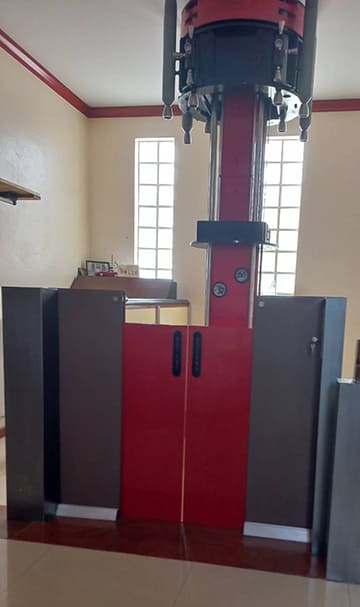
Get more of Elevator World. Sign up for our free e-newsletter.
